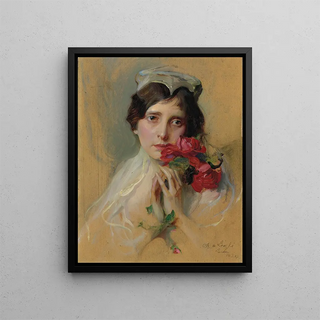Art print | Portrait of a lady wearing a pointed headdress - Philip Alexius de László


View from behind

Frame (optional)
In the vast panorama of art history, some works stand out for their ability to capture the essence of an era while revealing the depth of a personality. The art print Portrait of a lady wearing a pointed headdress by Philip Alexius de László is a perfect example. This painting, both intimate and mysterious, transports us to a world where fashion and art blend with elegance. László, a master of portraiture, succeeds in immortalizing not only the features of his model but also the atmosphere of a time marked by strict social conventions and a keen sense of aesthetics.
Style and uniqueness of the piece
The style of Philip Alexius de László is distinguished by its finesse and attention to detail. In this work, the lady, dressed in a pointed headdress, embodies timeless beauty. The delicate nuances of the skin, the subtle play of shadows and lights, as well as the texture of the clothing, demonstrate impressive technical mastery. László manages to create an intimate atmosphere, where each gaze seems charged with stories and secrets. The headdress, the centerpiece of the composition, draws the eye and highlights the sophistication of the fashion of the time. This focus on accessories and clothing details reveals not only the personality of the model but also the aesthetic norms of a bygone era. The work thus becomes a true visual testimony, an open window to a rich and complex past.
The artist and his influence
Philip Alexius de László, born in 1869 in Hungary, is a renowned portraitist whose talent has crossed borders. His career, marked by encounters with emblematic figures of his time, allowed him to develop a unique style that combines realism and romanticism. László captured the essence of his subjects, whether aristocrats, artists, or members of royalty. His influence is felt not only in the field of portraiture but also in the way he redefined the art of portraiture at the beginning of the 20th century. By choosing to depict his models in natural poses

Matte finish

View from behind

Frame (optional)
In the vast panorama of art history, some works stand out for their ability to capture the essence of an era while revealing the depth of a personality. The art print Portrait of a lady wearing a pointed headdress by Philip Alexius de László is a perfect example. This painting, both intimate and mysterious, transports us to a world where fashion and art blend with elegance. László, a master of portraiture, succeeds in immortalizing not only the features of his model but also the atmosphere of a time marked by strict social conventions and a keen sense of aesthetics.
Style and uniqueness of the piece
The style of Philip Alexius de László is distinguished by its finesse and attention to detail. In this work, the lady, dressed in a pointed headdress, embodies timeless beauty. The delicate nuances of the skin, the subtle play of shadows and lights, as well as the texture of the clothing, demonstrate impressive technical mastery. László manages to create an intimate atmosphere, where each gaze seems charged with stories and secrets. The headdress, the centerpiece of the composition, draws the eye and highlights the sophistication of the fashion of the time. This focus on accessories and clothing details reveals not only the personality of the model but also the aesthetic norms of a bygone era. The work thus becomes a true visual testimony, an open window to a rich and complex past.
The artist and his influence
Philip Alexius de László, born in 1869 in Hungary, is a renowned portraitist whose talent has crossed borders. His career, marked by encounters with emblematic figures of his time, allowed him to develop a unique style that combines realism and romanticism. László captured the essence of his subjects, whether aristocrats, artists, or members of royalty. His influence is felt not only in the field of portraiture but also in the way he redefined the art of portraiture at the beginning of the 20th century. By choosing to depict his models in natural poses






